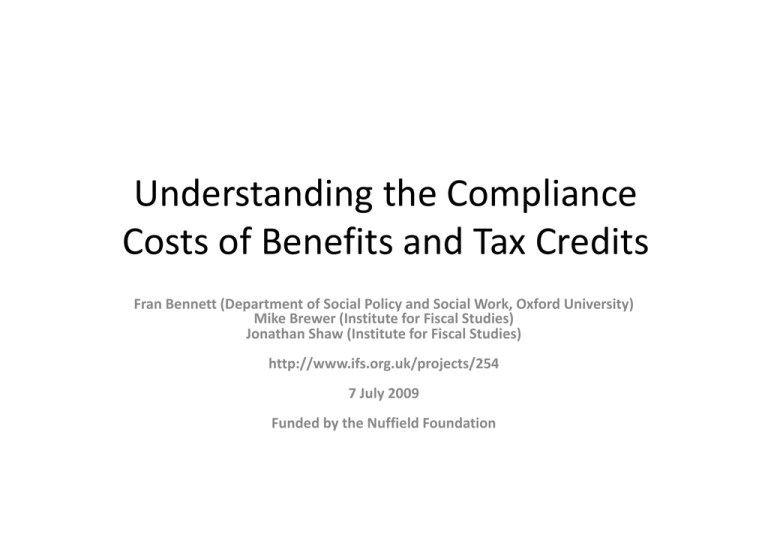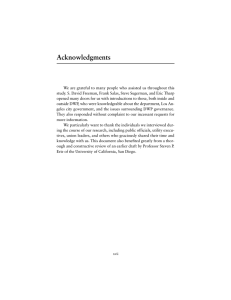Understanding the Compliance g p Costs of Benefits and Tax Credits
advertisement

Understanding the Compliance g p Costs of Benefits and Tax Credits Fran Bennett (Department of Social Policy and Social Work, Oxford University) Mike Brewer (Institute for Fiscal Studies) Jonathan Shaw (Institute for Fiscal Studies) Jonathan Shaw (Institute for Fiscal Studies) http://www.ifs.org.uk/projects/254 7 July 2009 7 July 2009 Funded by the Nuffield Foundation Outline • Overview of project: goals and scope, gy motivation and methodology • Cost benefit analysis + impact assessment • Broader policy context B d li • Nature and elements of ‘compliance costs’ for p claimants of benefits and tax credits • Investigating methods of measurement I ti ti th d f t • Conclusions and recommendations Project goals and scope Project goals and scope • SScoping project i j t to investigate ‘costs of compliance’ t i ti t ‘ t f li ’ of benefits and tax credits and whether they can be taken into account in assessing impact of (changes taken into account in assessing impact of (changes in) policies • Time, money, psychological costs in finding out about, claiming, getting payments, maintaining claim, coming off benefits/tax credits • Costs would disappear if no benefit/TC C t ld di if b fit/TC • What these costs involve: nature and range • Whether they can be measured, Wh th th b d and if so how d if h • (Not about whether people are ‘compliant’) Motivation • Why investigate compliance costs for benefits h i i li f b fi and tax credits claimants? ‐ Time spent fulfilling obligations cannot be p g g spent engaged in other activities ‐ More rounded measure of productivity of benefits/tax credits system (Atkinson) benefits/tax credits system (Atkinson) ‐ More understanding of non‐take‐up ‐ Improvement in citizens’ relationships with government? Methods exist for: M th d i tf • valuing individuals’ and companies’ costs of complying with tax authority complying with tax authority • valuing companies’ costs of complying with other government regulations government regulations • estimating time and money spent by individuals in complying with government regulations Given nature of compliance costs of receiving benefits and tax credits, how could these methods be applied? Methodology • Review of concept as applied in other areas ( g (e.g. taxation) and relevant studies ) • Review of (non‐)take‐up literature • Analysis of UK policy context A l i f UK li • Consultation with advisers and experts p • Consultation seminars (including civil servants/advisers, international exchange) t/ d i i t ti l h ) • Project report (including next steps) Cost benefit analysis and impact assessment • The Green Book: Appraisal and Evaluation in Central Government: ‘‘All new policies ... should be subject to comprehensive but proportionate ll l h ld b b h b assessment, wherever it is practicable, so as best to promote the public interest.’ ‘ ... describes how the economic, financial, social and environmental assessments of a policy ... should be combined’. • Cost benefit analysis at heart: Cost benefit analysis at heart: In principle, should take account of monetary value of all effects of changes, including ‘time effects of changes, including time costs costs’ • Impact assessments (IAs) for policy changes Current policy context Current policy context • IAs (and equality IAs) but incomplete • Reducing burdens on businesses Reducing burdens on businesses • Concern about ‘burdens on citizens’ (EU) ‐ N h l d ( Netherlands (www.whatarelief.eu) h li f ) • Benefit simplification p ((complexity index) p y ) • DWP investigating burdens (claiming JSA) • Measuring quality (productivity, DWP) and performance (customer satisfaction) • Service transformation i f i agenda d • ‘Customer insight’ g and ‘journey mapping’ j y pp g (Tell Us Once + Total Cost to Serve) • Welfare reform Welfare reform (growing conditionality) (growing conditionality) • Human rights perspective (respect) • Recognition of burdens on claimants key in p period of public spending pressure p p gp • Changes largely in helpful direction Nature and range of compliance costs for benefits and tax credits • Methods: literature and experts (not claimants) • Overview – but emphasises delivery not design + problematic cases; & indirect about claimants Costs: time, money, psychological, other? • Costs: time, money, psychological, other? ‐ time: e.g. telephone calls/form‐filling/office visit ‐ money: money e.g. telephone calls, transport to office, e g telephone calls transport to office fees/interest payments when delays ‐ psychological: e.g. worry, stigma, intrusion, disrespect … costs may overlap/be traded off • Most burdensome b d costs & & benefits/tax b fi / credits ‐ and groups with highest costs • Not measurement, but nature and p – whatever the cause(s) () implications • Stages of claim: ‐ finding out about systems and investigating eligibility finding out about systems and investigating eligibility ‐ claiming (and renewal) getting payments ‐ getting payments ‐ maintaining claim (e.g. reporting changes) g / ( g ) ‐ leaving benefits/tax credits (or moving from 1 to other) Finding out and claiming Finding out and claiming • Channels of communication (internet, h l f i i (i telephone, face to face): preference / costs • Rapid pace of change (familiarisation) • Take Take‐up up literature on hassle factors literature on hassle factors • ‘Faceless state’ or more convenient? • (Mobile) telephone charges ( bl ) l h h • Changing benefits/moving into paid work g g / g p • Importance of respect/trust/clarity/certainty Getting payments and maintaining the claim • Processing times/delays: constant theme i i /d l h • Payments to cover liabilities not coinciding y g • Reporting changes of circumstances (Burchardt 2008: time + income poverty) (Burchardt, 2008: time + income poverty) • Repetition of information frustrating • Different principles for different systems ff l f ff • Conditionality increasing for many y g y • Tax credits overpayments experience When things go wrong, challenging a decision, getting advice/advocacy • Administrative errors: claimant costs and p knock‐on impact on future trust • OFT and NAO implicitly recognise costs • Likely ‘win win’ for agencies and claimants Lik l ‘ i i ’ f i d l i • Feeling complaining/appealing will make no g p g/ pp g difference means denial of rights • Parliamentary Ombudsman principles P li t O b d i i l • Should include costs of getting advice Groups with high costs Groups with high costs • Often most vulnerable who have to make links f l bl h h k li k between different services • Frequent changes of circumstances • Physical/mental health: medical evidence Physical/mental health: medical evidence • Difficulties with English / literacy/numeracy • Identity/immigration issues / • Rural isolation • But even within groups, experiences differ Disentangling the causes? Disentangling the causes? • Whatever the cause, compliance costs occur • But if government interested in reducing costs of compliance, working out causation is important Administrative error more important than realise • Administrative error more important than realise • Delivery of benefits/tax credits • Design – Design e.g. means tests: complexity, stigma e g means tests comple it stigma • Particular benefits/tax credits – e.g. disability • Interaction of different benefits and tax credits is often confusing for claimants Issues arising for measurement Issues arising for measurement • Wide range of costs – average insufficient • Costs incurred by intermediaries? Costs incurred by intermediaries? • Conditionality: include ‐ but discount advantages? d ? • Other behavioural effects: exclude? • Disentangling impact of relationship with DWP/HMRC f DWP/HMRC from living on a low income li i l i • Claimants’ perceptions and priorities key Existing measurement methods: overview • Large‐scale surveys • Standard Cost Model (SCM) • Case studies/qualitative research Case studies/qualitative research • Non‐take‐up studies Large scale surveys: examples Large‐scale surveys: examples • Studies Studies of compliance costs of tax system frequently use surveys of compliance costs of tax system frequently use surveys (see section 3.1 for selected references) • Example: HMRC’s evaluation of short self‐assessment tax return, piloted for tax year 2002‐3 – Sampled from treatment group (short form) and control group S l df (h f ) d l (normal group) – Telephone survey, participants interviewed within 2 months of filingg – Median “compliance time” 120 mins for short form vs 162 mins for normal form – Measures of satisfaction higher for short form – Sample size large enough to estimate distribution of Sample size large enough to estimate distribution of “compliance time”. Also collected some covariates (http://www.hmrc.gov.uk/research/bolling.pdf) • DWP commissioned BMRB to estimate compliance costs of claiming DWP commissioned BMRB to estimate compliance costs of claiming JSA with phone survey of recent claimants • Government departments use surveys to estimate customer satisfaction Large scale surveys: pros and cons Large‐scale surveys: pros and cons • Statistically‐reliable estimates of St ti ti ll li bl ti t f – Average and total costs – Distribution of costs – Correlations with other characteristics • Can measure psychological costs • Recall error means should time survey to event being studied • Cost (especially of face‐to‐face) versus non‐response bias ( p y ) p • Difficult to explore – causes of compliance costs – claimants claimants’ perceptions and priorities perceptions and priorities Standard Cost Model: what is it? (1) Standard Cost Model: what is it? (1) • B Bottom‐up model of the total administrative burden and its causes tt d l f th t t l d i i t ti b d d it • Breaks down each legislation/regulation into detailed list of things people actually have to do • Each activity is costed, and grossed up to produce economy‐wide total • Assumes “normally‐efficient” business, or equivalent for individuals y q • Not intended to be statistically‐representative • Jargon: – SCM about “administrative burden”: “costs incurred by citizens in complying with information obligations ensuing from government regulations” – Does not include cost of other actions that individuals have to do in order to be compliant with government regulations ith t l ti – For example: MOT test. “Administrative burden” is time and expense of taking car to garage for test, and not cost of repairing car so that it passes NOT – Narrower concept than our “costs of compliance” Standard Cost Model: what is it? (2) Standard Cost Model: what is it? (2) Data req. 1 • M Map “legislation” to “l i l ti ” t “activities” Information Activity 1 Activity 2 Data req. 2 obligation 1 Activity 3 Data req. 3 Activity 4 Government regulation Information obligation 2 • Cost activities – Time – Money • Multiply up Multiply up – How many people affected? – How many times a year? y y Usually based on focus groups (“citizen panels”) expert opinion or other panels”), expert opinion or other qualitative methods U ll k Usually known from administrative data f d i i t ti d t Standard Cost Model: examples Standard Cost Model: examples • For business F b i – Estimate burdens imposed by government regulations (all government departments in UK, and many other countries) – Estimate burdens imposed by tax law (HMRC) Estimate burdens imposed by tax law (HMRC) – Linked to Impact Assessments, and government target to cut burdens on businesses by 25% • For individuals – Estimate burdens imposed by government regulations (The Netherlands, Austria, and i b d i db l i ( h h l d i d planned in Belgium Germany and Latvia) • The Netherlands is a pioneer of SCM, but now seems to be having second The Netherlands is a pioneer of SCM but now seems to be having second thoughts. Still has target to reduce burdens on citizens, monitored through SCM, but now accompanied by increased focus on citizens’ priorities: – Not all costs viewed equally by citizens, and citizens recognise benefits are associated with costs : “top 10 irritants” – Perceptions may differ from reality (Balance Model) Standard Cost Model: pros and cons Standard Cost Model: pros and cons • Estimates Estimates total and average costs total and average costs • Detailed tool allowing ex ante analysis of policy & operational changes • All costs can be attributed to underlying cause All costs can be attributed to underlying cause • “role of [SCM] is to drive a culture change … by helping to focus their attention on what obligations mean for business” • Statistical (im)precision of estimates – Garbage in, garbage out (Garbage In, Gospel Out?) Garbage in garbage out (Garbage In Gospel Out?) • Measures something narrower than compliance costs – Costs incurred in understanding requirements – Psychological costs Psychological costs – Costs of things required to do by regulation • Doesn’t easily allow for variation in costs (ie distribution of costs) Qualitative research: examples, and pros and cons • Studies of compliance costs of tax system have used Studies of compliance costs of tax system have used “case case studies studies” (see review (see review by Chris Evans for references) • Example: Budlender et al. (2005) on Child Support Grant (in South Africa) – Combines SCM approach with aspects of qualitative research and (small‐ Combines SCM approach with aspects of qualitative research and (small scale) “random” survey – Sampled 55 women who had just claimed Child Support Grant – Asked about activities undertaken in order to claim, and time and cost of each – Also estimated cost to public sector – Scaled up to produce aggregate cost • Much qualitative research is about experiences and views of benefit or tax Much qualitative research is about experiences and views of benefit or tax credit recipients, but not with focus on compliance cost nor measuring time and money. • • • Can be focused precisely on policy Can be focused precisely on policy‐makers makers needs or questions needs or questions Very good at eliciting claimants’ perspective Not statistically representative and can’t easily produce quantified estimates Non‐take‐up research: examples, and pros and cons • Much Much qualitative and quantitative (econometric) research on non‐ qualitative and quantitative (econometric) research on non take‐up in UK (see section 3.5 for some references) • Qualitative research with eligible non‐recipients can indicate nature g p of costs incurred by recipients f i db i i • Quantitative research can indicate which characteristics are associated with non‐take‐up associated with non take up, but can but can’tt identify true causes identify true causes • “Revealed preference” arguments attempt to value the “costs” which prevent an individual from claiming • But – Non‐take‐up caused by more than just compliance costs – Non‐take‐up Non take up driven by expectations and perceptions, actual compliance driven by expectations and perceptions actual compliance costs are measurable facts – Revealed preference studies usually apply static framework to dynamic decisions, and validity of estimates rests on many statistical assumptions , y y p Summary of findings Summary of findings • Government must value the time and effort spent by claimants in meeting Government must value the time and effort spent by claimants in meeting demands placed on them by benefits and tax credits regulations – – – – • If not, then only partial cost‐benefit analysis High compliance costs can cause behavioural impacts which work against DWP objectives High compliance costs can alienate recipients, and lead to distrust of government Should be guided by claimants’ priorities But compliance costs incurred by benefit and TC recipients tricky to measure – Many costs are psychological or on Many costs are psychological or on‐going going – Costs may fall on claimant, family and friends, or advice agencies – Costs of conditionality? • • • None of existing methods well‐suited to measuring all aspects of compliance costs of benefits and TCs fb fit d TC CBA and IA: potential to include costs of compliance, but not always realised Current policy changes in helpful direction, but costs of compliance not yet key or measured So what next? So what next? • • • • DWP’s JSA study seems good use of survey to measure compliance costs DWP’s JSA study seems good use of survey to measure compliance costs HMRC should consider using survey of TC/CB recipients to ask about compliance costs explicitly Consider high frequency diaries or surveys as way of measuring on going Consider high‐frequency diaries or surveys as way of measuring on‐going costs or those not linked to discrete event SCM not attractive to us, but can see appeal to policy‐makers. If pursued, DWP and HMRC must DWP and HMRC must – Allow for variation in costs between citizens – Cost when things go wrong, not some ideal scenario – Spend as much time and money populating the model with robust estimates Spend as much time and money populating the model with robust estimates • • DWP and HMRC should consider research into claimants’ biggest irritations or stressful aspects of dealing with authorities Include compliance costs when considering policy or operational changes! Include compliance costs when considering policy or operational changes! End


